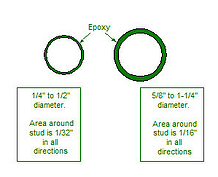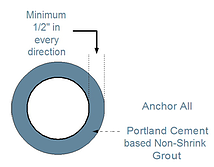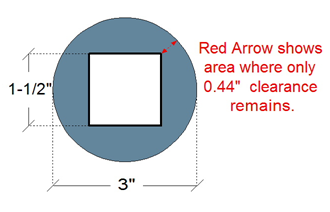This blog applies to setting threaded studs, handrail posts, anchor bolts, rebar, etc.
Note: This discussion only covers how hole diameter effects pull out strength. Obviously, the depth of embedment is also a major factor.
When anything is set in concrete, the hole diameter vs. the type of anchoring material used will play a critical role in the eventual pull out strength. As a general rule, you want the pull out strength to be greater than the tensile strength of the stud, anchor bolt, rebar, etc.
For maximum efficiency, the hole diameter should be a function of the anchoring material. The two most common anchors are Epoxy and Grout. Simply, epoxy can work with less clearance than grout. As an example, the epoxy produced by Redhead, EPCON A-7, indicates;
 Rods Diameter 1/4” to 1/2”;
Rods Diameter 1/4” to 1/2”;
Drill hole 1/16” larger than rod diameter
Rods Diameter 5/8” to 1-1/4”;
Drill hole 1/8” larger than rod diameter
Any larger than that and the epoxy will not function as intended.
Portland Cement Based Non-Shrink Grout
On the other hand, cementitious non-shrink grout requires at least 1/2” clearance around all sides to develop its full compressive strength. So for a 1-1/4 diameter schedule 40 pipe, with an O.D. of 1.66", the hole should be no less than 2.66”. In this case, the erector would most likely use the core drill next size up, which would be 3” diameter.
 Converse to the epoxy requirements, when using Anchor All, there is no limit on how much larger the hole can be, as long as it provides at least the required 1/2” clearance in every direction.
Converse to the epoxy requirements, when using Anchor All, there is no limit on how much larger the hole can be, as long as it provides at least the required 1/2” clearance in every direction.
This is also true when setting square posts. As shown in the square post drawing below, a 1-1/4” square tube being set in a 3” diameter hole leaves only 0.44” clearance at each corner. If installed as shown cracking and/or premature failure could occur. Also, simple calculations would show anyone examining this installation proper procedure was not followed. This could result in charge-backs or retainage being withheld.
This, along with greater depth range, is why the EZ Sleeve is available in a larger 4” x 12”  model. To learn more about the EZ Sleeves we carry, click below to view the options:
model. To learn more about the EZ Sleeves we carry, click below to view the options:
The other important factor to consider when determining the hole diameter is cost of the epoxy. By comparison, Epoxies can cost 20 to 25 times what Anchor All Cement based non-shrink grout costs. To learn more about this, click below to view our hydraulic cement and non-shrink grout products.






